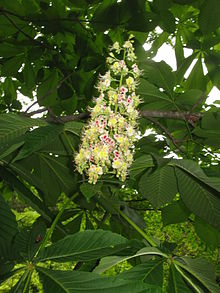Content deleted Content added
2a00:1028:83cc:42d2:113f:cc30:924c:495d (talk) No edit summary |
Necrothesp (talk | contribs) name |
||
| Line 21: | Line 21: | ||
|synonyms_ref = <ref name="asdfhuoefoqwue"/><ref>[http://www.tropicos.org/Name/50182812?tab=synonyms Tropicos Aesculus turbinata]</ref><ref>[http://www.theplantlist.org/tpl/record/kew-2624593 Plant list Aesculus turbinata]</ref> |
|synonyms_ref = <ref name="asdfhuoefoqwue"/><ref>[http://www.tropicos.org/Name/50182812?tab=synonyms Tropicos Aesculus turbinata]</ref><ref>[http://www.theplantlist.org/tpl/record/kew-2624593 Plant list Aesculus turbinata]</ref> |
||
}} |
}} |
||
'''''Aesculus turbinata''''', common name "'''Japanese horse-chestnut'''" is native to Japan but cultivated elsewhere. It is a tree up to 30 m tall. Flowers are white to pale yellowish with red spots. Capsules are dark brown, obovoid to pyriform.<ref>Blume, Rumphia. 3: 195. 1847. </ref><ref name="asdfhuoefoqwue">[http://www.efloras.org/florataxon.aspx?flora_id=2&taxon_id=200013165 Flora of China vol 12 page 4.]</ref> The seeds were traditionally eaten, after [[parboiling|leaching]], by the [[Jōmon period|Jōmon people]] of Japan over about four millennia, until 300 AD.<ref>{{cite book|last=Harlan|first=Jack R.|title=The Living Fields: Our Agricultural Heritage|year=1995|publisher=Cambridge Univ. Press|location=Cambridge [u.a.]|isbn=0-521-40112-7|edition=1. publ.|page=15}}Harlan cites Akazawa, T & Aikens, CM, ''Prehistoric Hunter-Gathers in Japan'' (1986), Univ. Tokyo Press; and cites Aikens, CM & Higachi, T, ''Prehistory of Japan'' (1982), NY Academic Press.</ref> |
'''''Aesculus turbinata''''', common name "'''Japanese horse-chestnut'''" ({{nihongo|''Tochinoki'' or ''Tochi''|トチノキ(栃の木) or トチ(栃、橡)}}, is native to Japan but cultivated elsewhere. It is a tree up to 30 m tall. Flowers are white to pale yellowish with red spots. Capsules are dark brown, obovoid to pyriform.<ref>Blume, Rumphia. 3: 195. 1847. </ref><ref name="asdfhuoefoqwue">[http://www.efloras.org/florataxon.aspx?flora_id=2&taxon_id=200013165 Flora of China vol 12 page 4.]</ref> The seeds were traditionally eaten, after [[parboiling|leaching]], by the [[Jōmon period|Jōmon people]] of Japan over about four millennia, until 300 AD.<ref>{{cite book|last=Harlan|first=Jack R.|title=The Living Fields: Our Agricultural Heritage|year=1995|publisher=Cambridge Univ. Press|location=Cambridge [u.a.]|isbn=0-521-40112-7|edition=1. publ.|page=15}}Harlan cites Akazawa, T & Aikens, CM, ''Prehistoric Hunter-Gathers in Japan'' (1986), Univ. Tokyo Press; and cites Aikens, CM & Higachi, T, ''Prehistory of Japan'' (1982), NY Academic Press.</ref> |
||
==References== |
==References== |
||
Revision as of 08:40, 18 September 2014
| Aesculus turbinata | |
|---|---|

| |
| Scientific classification | |
| Kingdom: | |
| (unranked): | |
| (unranked): | |
| (unranked): | |
| Order: | |
| Family: | |
| Genus: | |
| Species: | A. turbinata
|
| Binomial name | |
| Aesculus turbinata Blume
| |
| Synonyms[1][2][3] | |
| |
Aesculus turbinata, common name "Japanese horse-chestnut" (Tochinoki or Tochi (トチノキ(栃の木) or トチ(栃、橡)), is native to Japan but cultivated elsewhere. It is a tree up to 30 m tall. Flowers are white to pale yellowish with red spots. Capsules are dark brown, obovoid to pyriform.[4][1] The seeds were traditionally eaten, after leaching, by the Jōmon people of Japan over about four millennia, until 300 AD.[5]
References
- ^ a b Flora of China vol 12 page 4.
- ^ Tropicos Aesculus turbinata
- ^ Plant list Aesculus turbinata
- ^ Blume, Rumphia. 3: 195. 1847.
- ^ Harlan, Jack R. (1995). The Living Fields: Our Agricultural Heritage (1. publ. ed.). Cambridge [u.a.]: Cambridge Univ. Press. p. 15. ISBN 0-521-40112-7.Harlan cites Akazawa, T & Aikens, CM, Prehistoric Hunter-Gathers in Japan (1986), Univ. Tokyo Press; and cites Aikens, CM & Higachi, T, Prehistory of Japan (1982), NY Academic Press.